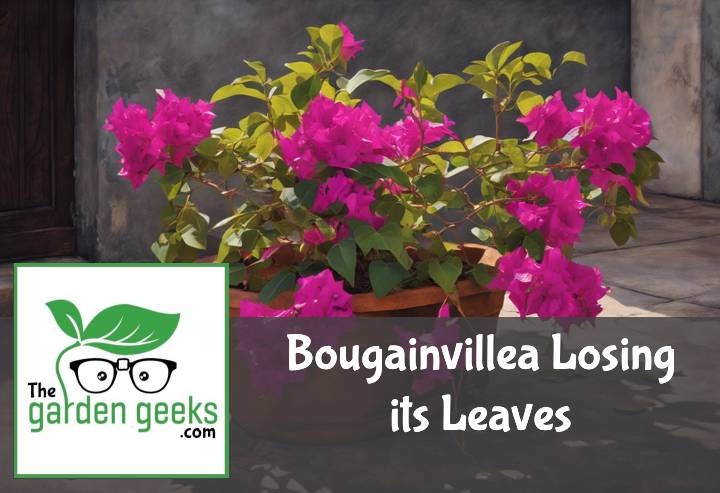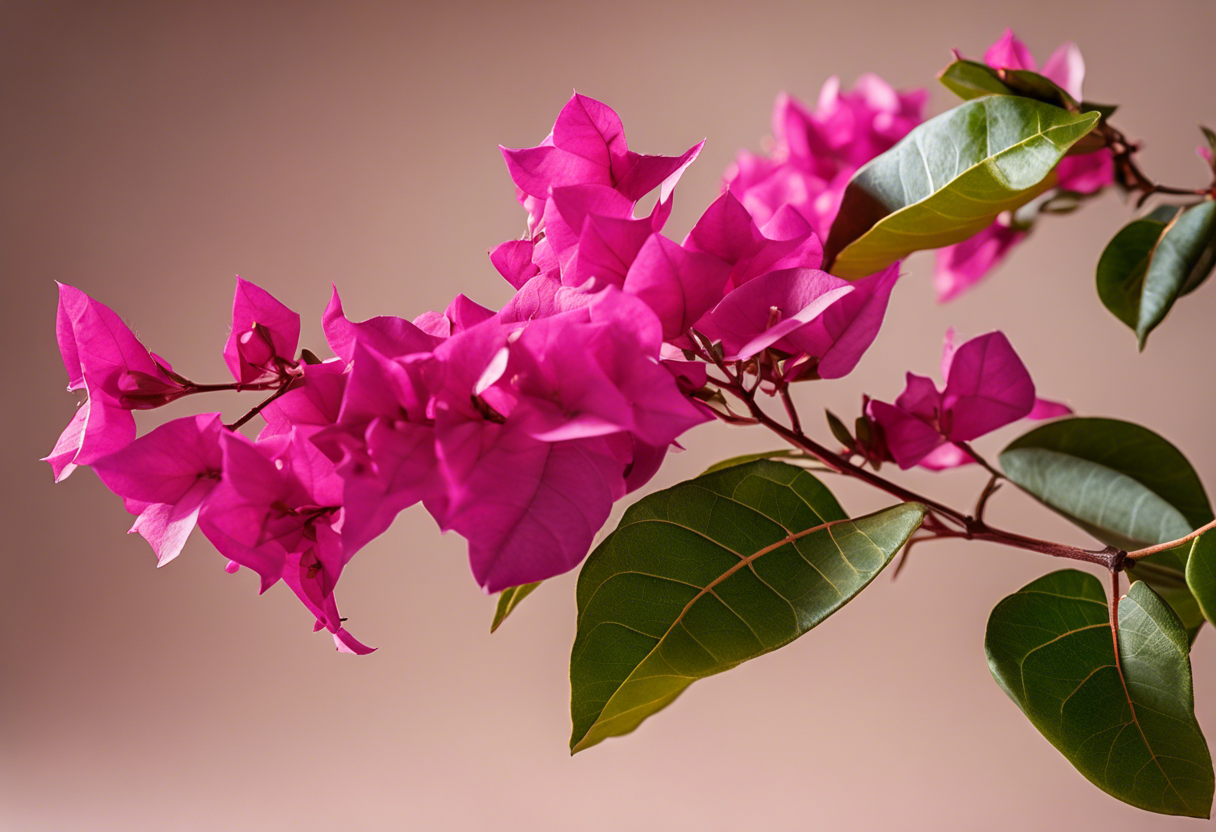Ever looked at your once vibrant Bougainvillea Losing its Leaves and wondered what went wrong? I know, it’s like watching your favorite sitcom character written off the show. One day they’re there, adding color and life to your garden, the next – poof – they’re gone!
Don’t fret though! Just like that sitcom character might get a spin-off, there’s hope for your Bougainvillea yet. We’ll dive into why this might be happening and how you can save your plant from becoming a leafless stick in the mud. Keep reading about ‘Bougainvillea Losing its Leaves? (How to Save it)’!
Key Takeaways
- Bougainvillea losing its leaves is often due to overwatering, lack of sunlight, or nutrient deficiencies.
- To save it, adjust watering based on the plant’s needs and environment. Overwatering can lead to root rot.
- Ensure the plant gets at least 5 hours of sunlight daily.
- Use a balanced fertilizer to address nutrient deficiencies.
- If these steps don’t work, consider repotting the plant in fresh soil or consulting with a horticulturist.
Understanding Bougainvillea
The Bougainvillea plant is a vibrant, tropical spectacle that’s become a favorite among garden enthusiasts. Known for its striking colors and lush foliage, it’s the epitome of natural beauty. But when your Bougainvillea starts losing its leaves, it can be quite a heartbreak.
What is a Bougainvillea?
Originating from South America, the Bougainvillea is an evergreen vine known for its flamboyant display of flowers. It’s named after Louis Antoine de Bougainville, the French admiral who discovered it during his voyage in the 1760s.
The features of Bougainvillea are truly captivating. With thorny, woody vines and large, glossy leaves, this plant bursts into a riot of color when in bloom. The actual flowers are small and white, but it’s the colorful bracts – leaf-like structures surrounding the flowers – that steal the show.
Importance of Leaves to Bougainvillea
Leaves play a vital role in any plant’s life as they’re responsible for photosynthesis – converting light energy into food for growth. For Bougainvilleas, this process is no different.
However, beyond just health benefits, leaves also contribute significantly to the aesthetic value of these plants. The lush greenery provides a perfect backdrop for those brilliant bracts we all love so much. So when you notice your Bougainvillea losing its leaves, it’s not just about looks; it could signal an underlying health issue that needs immediate attention!
Why is Your Bougainvillea Losing its Leaves?
If you’re noticing your Bougainvillea losing its leaves, don’t panic just yet. It could be due to a few reasons, including natural leaf drop, environmental stressors, or pesky pests and diseases.
Natural Leaf Drop
First off, let’s talk about natural bougainvillea leaf drop. Yes, you heard it right! Just like us humans shedding hair, bougainvilleas also shed their leaves as part of their lifecycle. This is completely normal and nothing to worry about.
However, the key here is to differentiate between healthy leaf loss and problematic one. If the leaves are older and fall off without any discoloration or spots, that’s just your plant doing its thing – a part of the bougainvillea lifecycle.
Environmental Stressors
Now onto the environmental factors causing bougainvillea leaf loss. These plants can be a bit dramatic when it comes to changes in their environment.
Temperature fluctuations? They’ll throw a fit by dropping leaves! Same goes for water levels – too much or too little can cause them distress leading to leaf drop. And let’s not forget sunlight exposure; these sun-loving plants need plenty of light for optimal health.
Pests and Diseases
Finally, we have pests and diseases causing your bougainvillea to lose its leaves. Common culprits include aphids, scale insects and fungal diseases like powdery mildew.
Identifying pest damage can be tricky but look out for discolored or distorted leaves. As for diseases, watch out for unusual spots or growth on the leaves. Treating these issues early can save your bougainvillea from severe damage.
How to Diagnose the Cause of Leaf Loss
When your Bougainvillea Losing its Leaves, it’s crucial to diagnose the cause. It could be due to stress or common pests and diseases. Let’s dive into how you can identify these issues.
Identifying Signs of Stress in Bougainvillea
First off, let’s talk about signs of stressed Bougainvillea. If your plant is under stress, it might show symptoms like wilting, yellowing leaves, or stunted growth. These are all symptoms of unhealthy plants that need immediate attention.
Next up, look for signs of overwatering or underwatering. Overwatered Bougainvilleas often have soggy roots and leaves that turn yellow then brown. On the other hand, underwatered ones may have dry soil and drooping leaves.
Finally, check if your plant gets enough light. A lack of sunlight can lead to leaf drop as well. So keep an eye out for these Bougainvillea health indicators!
Common Pests and Diseases Affecting Bougainvillea
Now onto pests and diseases! Some common culprits causing Bougainvillea leaf drop causes include aphids, mealybugs, and spider mites. These tiny critters suck the life out of your plant leading to leaf loss.
Fungal diseases can also cause trouble for your Bougainvillea. Root rot is a common one where the roots become mushy and discolored due to overwatering or poor drainage.
And don’t forget about bacterial leaf spot! This disease causes spots on leaves which eventually fall off. So watch out for these common diseases in plants when diagnosing why your Bougainvillea is losing its leaves.
How to Save Your Bougainvillea
Hey there, plant lover! If you’re here because you’ve noticed your Bougainvillea Losing its Leaves, don’t fret. We’ve got some top-notch bougainvillea care tips to help you out. It’s all about tweaking your care routine, treating those pesky pests and diseases, and knowing when it’s time to call in the pros.
Adjusting Care Routine for Healthy Growth
First things first, let’s talk about water. Your bougainvillea isn’t a cactus, but it doesn’t like soggy feet either. Adjust your bougainvillea watering routine so that the soil is moist, not drenched.
Next up is sunlight. These beauties are sun worshippers! Make sure they get plenty of light for healthy growth. But remember, too much of anything can be bad. So balance the sunlight needs for bougainvillea with some shade during peak hours.
Lastly, let’s chat about food – or rather fertilizer. A little boost can go a long way in promoting healthy bougainvillea growth. Just be careful not to overdo it!
Treating Pests and Diseases
Now onto the less fun stuff – pests and diseases. If your bougainvillea is losing leaves, it could be due to unwanted visitors or illness. Common culprits include aphids and fungal infections.
For pest control, consider using an organic pesticide as part of your bougainvillea pests treatment plan. For diseases in bougainvilleas like fungus, a good fungicide should do the trick.
Remember though; prevention is better than cure! Regularly inspect your plant for early signs of trouble.
When to Seek Professional Help
Sometimes despite our best efforts, our green friends need more help than we can provide. If you’ve tried everything and your bougainvillea is still struggling, it might be time to seek professional help for bougainvilleas.
Signs that it’s time to call in a plant expert include severe leaf drop, stunted growth, or if your plant looks more like a Halloween prop than a vibrant flowering shrub. Don’t worry though; with the right care, your bougainvillea will be back to its blooming best in no time!
Preventive Measures for Future Leaf Loss
Preventing bougainvillea losing its leaves is a lot easier when you’ve got the right preventive measures in place. It’s all about proper planting, care techniques, and regular monitoring. Let’s dive into these topics!
Proper Planting and Care Techniques
When it comes to bougainvillea planting guide, the first thing to consider is soil type. Bougainvilleas love well-drained soil. So, make sure you’re not planting your bougainvillea in clay or overly moist soil.
Next up is watering frequency. Overwatering can lead to leaf loss, so be careful! Water your bougainvillea only when the top few inches of soil are dry.
And let’s not forget sunlight exposure. These plants are sun-lovers! Ensure your bougainvillea gets at least 6 hours of direct sunlight each day for a healthy growth.
Regular Monitoring and Maintenance
Regular plant monitoring is key to prevent leaf loss in bougainvilleas. Keep an eye out for pests as they can cause significant damage to your plant leading to leaf drop.
Pest control should be part of your bougainvillea maintenance tips. Use organic pesticides if necessary, but remember that prevention is always better than cure!
Lastly, don’t underestimate the power of pruning! Correctly pruning bougainvilleas helps maintain their shape and promotes healthier growth which ultimately prevents leaf loss. So grab those shears and get pruning!
To Wrap Up
Like a drama queen demanding attention, your Bougainvillea losing its leaves is a cry for help. It’s saying “Hey there, give me more sunlight, less water, and check my roots!” Remember that these vibrant divas are sun-worshippers and hate soggy feet.
In the end, it’s all about striking that perfect balance. So don’t be disheartened if you’re seeing leaf drop; with patience and care you’ll soon have your Bougainvillea back to its flamboyant self. For more information on Bougainvillea Losing its Leaves, feel free to explore further!





